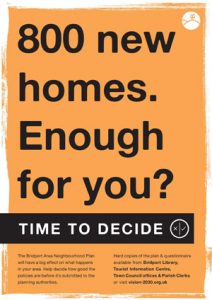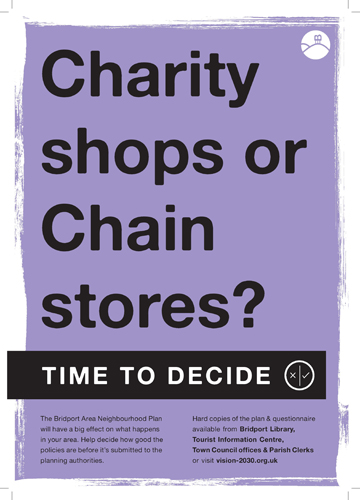It’s make your mind up time as Bridport and the surrounding area maps out what the future might look like in the next eighteen years. Margery Hookings speaks to Phyllida Culpin about the Bridport Area Neighbourhood Plan, one of the most important initiatives the town and surrounding parishes have seen for years.
If you’re out and about in Bridport over the next six weeks, your attention is likely to be grabbed by an unusual poster campaign.
Designed by a local company, it’s deliberately eye-catching. It wants to be noticed, to make people find out more.
The campaign is just one of the weapons in the armoury for final public consultation on the Bridport Area Neighbourhood Plan. This is not just a dry document with a boring name. This is important stuff. It’s Bridport’s future we’re talking out.
The plan is destined to have a huge impact on what happens in the town and the neighbouring parishes of Allington, Symondsbury, Bradpole, Bothenhampton and Walditch. So it’s vital that local people decide if they like the policies contained within it before the plan is submitted to the planning authorities.
These cover climate change, housing, economy and employment, the town centre, landscape and heritage, community facilities and access and movement.
 Bridport and its environs are special. But the area can’t afford to stand still or preserve itself in a gentrified aspic. It needs to hang on to what makes it stand out from the crowd but, at the same time, it has to live and breathe and continue to thrive.
Bridport and its environs are special. But the area can’t afford to stand still or preserve itself in a gentrified aspic. It needs to hang on to what makes it stand out from the crowd but, at the same time, it has to live and breathe and continue to thrive.
The neighbourhood planning system was introduced by the Localism Act of 2011.
According to the Ministry of Housing, Communities & Local Government, neighbourhood planning gives communities direct power to develop a shared vision for their neighbourhood and shape the development and growth of their local area.
They are able to choose where they want new homes, shops and offices to be built, have their say on what those new buildings should look like and what infrastructure should be provided, and grant planning permission for the new buildings they want to see go ahead.
Neighbourhood planning provides a powerful set of tools for local people to ensure that they get the right types of development for their community where the ambition of the neighbourhood is aligned with the strategic needs and priorities of the wider local area.
“What’s good about ours is that it covers a logical, geographical area,” says Phyllida Culpin, who chairs the Bridport Area Neighbourhood Plan steering group, which is made up of people from the five parishes.
She’s lived in Bridport for seven years and has 20 years’ experience as a housing professional with a background in regeneration of large estates, community development, social cohesion and development of employment and training for residents.
The skills of all those involved in the plan are wide-ranging. Working together, more than 100 volunteers on six working groups have developed a blueprint which is community-led, rather than something imposed by a faceless committee.
 Since January 2015 when the original steering group was formed, word of the evolving plan has been spread through attendance at, for example, village fetes, stands in Bucky Doo Square and leaflets to every household in the area.
Since January 2015 when the original steering group was formed, word of the evolving plan has been spread through attendance at, for example, village fetes, stands in Bucky Doo Square and leaflets to every household in the area.
An ‘intentions document’ was produced last summer and more than 20 per cent of the community responded, highlighting the importance of affordable housing and safeguarding the independent, special character of the parishes and town
“The Bridport Area Neighbourhood Plan is really the only way that our community can have a say on future development in the area,” Phyllida says.
“Yes, we can go along to planning meetings and say what we think but, in many ways, that’s too late. The neighbourhood plan, however, can reflect the needs of the parishes and the community.”
The Bridport Area Neighbourhood Plan represents the locals’ best chance of getting what they want for the town and its surrounds. Once such plans are adopted, local councils and government take notice. An approved neighbourhood plan will influence decisions about future development in the Bridport area.
Back to the Ministry of Housing, Communities & Local Government:
Neighbourhood planning enables communities to play a much stronger role in shaping the areas in which they live and work and in supporting new development proposals. This is because unlike the parish, village or town plans that communities may have prepared, a neighbourhood plan forms part of the development plan and sits alongside the Local Plan prepared by the local planning authority.
Decisions on planning applications will be made using both the Local Plan and the neighbourhood plan, and any other material considerations.
Neighbourhood planning provides the opportunity for communities to set out a positive vision for how they want their community to develop over the next 10, 15, 20 years in ways that meet identified local need and make sense for local people.
They can put in place planning policies that will help deliver that vision or grant planning permission for the development they want to see.
“We’re trying to reach as many people as we can,” Phyllida Culpin says. “Everyone is being told what is happening—that’s it’s time to decide. Have we got it right? Are these the right things for the area? Once we have people’s feedback, we can amend the plan in line with what people say.”
The final plan is due to be submitted to West Dorset District Council by November this year. This will be followed by a public referendum in the spring of 2019. If 50 per cent of those who vote are in favour, the Bridport Area Neighbourhood Plan will be approved.
Summary of Policies
Climate change
- Monitoring carbon footprint
- Energy efficiency for new developments
- Energy generation to offset predicted energy requirements
- Neighbourhood renewable energy schemes
- Flood risk assessment to remain valid for the lifetime of developments
Housing
- General affordable housing policy (minimum of 35 per cent)
- Design of affordable housing fully integrated into all developments
- Affordable housing and phased development
- Housing mix and balanced community
- Housing design
- Custom build and self-build homes
- Community-led housing development (release of sites not normally permitted)
- Principal residence requirement (to control growth of holiday homes)
Economy & employment
- Protection of existing employment land and uses
- Provision for new and small businesses
- Sustainable tourism that demonstrate a positive impact
Town centre
- Retail, high street and food/drink uses
- Developments fostering small business activity
- Support for creative industries
- Support for development proposals that improve the public realm across the plan area
- Town centre renewal and rejuvenation
- Shopfront design
Landscape and heritage
- Green corridors, footpaths, surrounding hills and skylines
- Biodiversity and wildlife
- Anti-coalescence measures to retain character and setting of settlements
- Local green spaces of community value protected from built development
Community facilities
- Protection of existing and new community infrastructure
- New community services and facilities supported where need is identified
Access and movement
- Promotion of active travel modes, priority to pedestrians movements
- Streets for all
- Connections to sustainable transport
- Footpath and cycle networks
- Contributions from community infrastructure levy to go towards maintaining and improving
footpaths and cycle network
- Retain and enhance Bridport bus station and surrounding land as local transport hub











